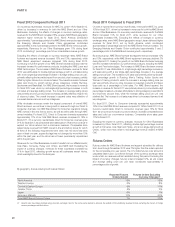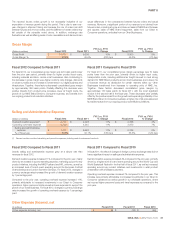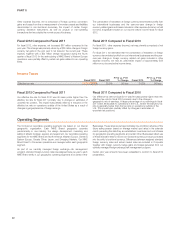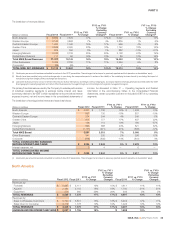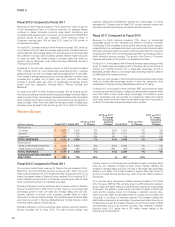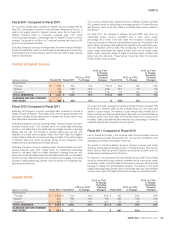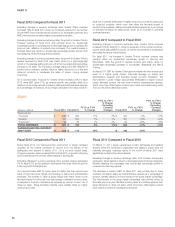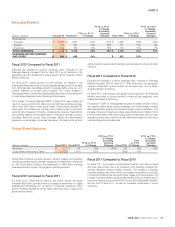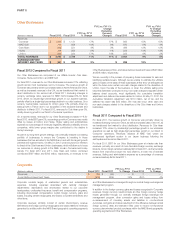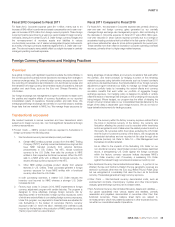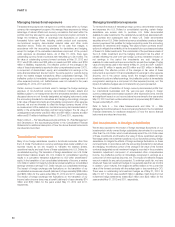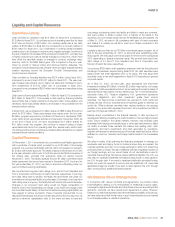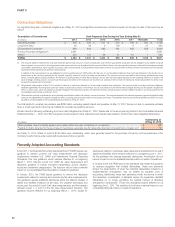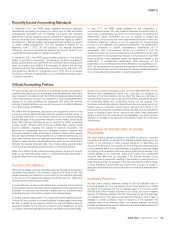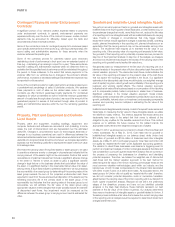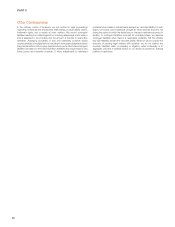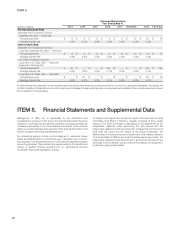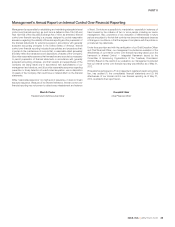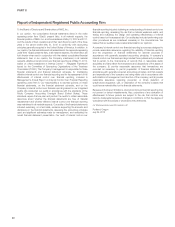Nike 2012 Annual Report Download - page 30
Download and view the complete annual report
Please find page 30 of the 2012 Nike annual report below. You can navigate through the pages in the report by either clicking on the pages listed below, or by using the keyword search tool below to find specific information within the annual report.PART II
Managing transactional exposures
Transactional exposures are managed on a portfolio basis within our foreign
currency risk management program. We manage these exposures by taking
advantage of natural offsets and currency correlations that exist within the
portfolio and may also elect to use currency forward and option contracts to
hedge the remaining effect of exchange rate fluctuations on probable
forecasted future cash flows, including certain product cost exposures,
non-functional currency denominated external sales and other costs
described above. These are accounted for as cash flow hedges in
accordance with the accounting standards for derivatives and hedging,
except for hedges of the embedded derivatives component of the product
costs exposure as discussed below. As of May 31, 2012, there were
outstanding currency forward contracts with maturities up to 24 months. The
fair value of outstanding currency forward contracts at May 31, 2012 and
2011 was $183 million and $28 million in assets and $32 million and $136
million in liabilities, respectively. The effective portion of the changes in fair
value of these instruments is reported in other comprehensive income (“OCI”),
a component of shareholders’ equity, and reclassified into earnings in the
same financial statement line item and in the same period or periods during
which the related hedged transactions affect consolidated earnings. The
ineffective portion is immediately recognized in earnings as a component of
other expense (income), net. Ineffectiveness was not material for the years
ended May 31, 2012, 2011 and 2010.
Certain currency forward contracts used to manage the foreign exchange
exposure of non-functional currency denominated monetary assets and
liabilities subject to re-measurement and the embedded derivative contracts
discussed above are not formally designated as hedging instruments under
the accounting standards for derivatives and hedging. Accordingly, changes
in fair value of these instruments are immediately recognized in other expense
(income), net and are intended to offset the foreign currency impact of the
re-measurement of the related non-functional currency denominated asset or
liability or the embedded derivative contract being hedged. The fair value of
undesignated instruments was $55 million and $9 million in assets and $20
million and $17 million in liabilities at May 31, 2012 and 2011, respectively.
Refer to Note 6 — Fair Value Measurements and Note 16 – Risk Management
and Derivatives in the accompanying Notes to the Consolidated Financial
Statements for additional description of how the above financial instruments
are valued and recorded.
Translational exposures
Many of our foreign subsidiaries operate in functional currencies other than
the U.S. Dollar. Fluctuations in currency exchange rates create volatility in our
reported results as we are required to translate the balance sheets,
operational results and cash flows of these subsidiaries into U.S. Dollars for
consolidated reporting. The translation of foreign subsidiaries’ non-U.S. Dollar
denominated balance sheets into U.S. Dollars for consolidated reporting
results in a cumulative translation adjustment to OCI within shareholders’
equity. In the translation of our consolidated statements of income, a weaker
U.S. Dollar in relation to foreign functional currencies benefits our consolidated
earnings whereas a stronger U.S. Dollar reduces our consolidated earnings.
The impact of foreign exchange rate fluctuations on the translation of our
consolidated revenues was a benefit (detriment) of approximately $268 million
and $(28) million for the years ended May 31, 2012 and 2011, respectively.
The impact of foreign exchange rate fluctuations on the translation of our
income before income taxes was a benefit (detriment) of approximately $74
million and $(16) million for the years ended May 31, 2012 and 2011,
respectively.
Managing translational exposures
To minimize the impact of translating foreign currency denominated revenues
and expenses into U.S. Dollars for consolidated reporting, certain foreign
subsidiaries use excess cash to purchase U.S. Dollar denominated
available-for-sale investments. The variable future cash flows associated with
the purchase and subsequent sale of these U.S. Dollar denominated
securities at non-U.S. Dollar functional currency subsidiaries creates a foreign
currency exposure that qualifies for hedge accounting under the accounting
standards for derivatives and hedging. We utilize forward contracts and/or
options to mitigate the variability of the forecasted future purchases and sales
of these U.S. Dollar investments. The combination of the purchase and sale of
the U.S. Dollar investment and the hedging instrument has the effect of
partially offsetting the year-over-year foreign currency translation impact on
net earnings in the period the investments are sold. Hedges of
available-for-sale investments are accounted for as cash flow hedges. The fair
value of instruments used in this manner at May 31, 2012 and 2011 was $27
million and $1 million in assets and $3 million and $21 million in liabilities,
respectively. The effective portion of the changes in fair value of these
instruments is reported in OCI and reclassified into earnings in other expense
(income), net in the period during which the hedged available-for-sale
investment is sold and affects earnings. Any ineffective portion is immediately
recognized in earnings as a component of other expense (income), net. The
impact of ineffective hedges was not material for any period presented.
The combination of translation of foreign currency-denominated profits from
our international businesses and the year-over-year change in foreign
currency related gains and losses included in other expense (income), net had
an insignificant impact on our income before income taxes for the year ended
May 31, 2012 and had a unfavorable impact of approximately $33 million for
the year ended May 31, 2011.
Refer to Note 6 — Fair Value Measurements and Note 16 — Risk
Management and Derivatives in the accompanying Notes to the Consolidated
Financial Statements for additional description of how the above financial
instruments are valued and recorded.
Net investments in foreign subsidiaries
We are also exposed to the impact of foreign exchange fluctuations on our
investments in wholly-owned foreign subsidiaries denominated in a currency
other than the U.S. Dollar, which could adversely impact the U.S. Dollar value
of these investments and therefore the value of future repatriated earnings.
We hedge certain net investment positions in Euro-functional currency foreign
subsidiaries to mitigate the effects of foreign exchange fluctuations on these
net investments. In accordance with the accounting standards for derivatives
and hedging, the effective portion of the change in fair value of the forward
contracts designated as net investment hedges is recorded in the cumulative
translation adjustment component of accumulated other comprehensive
income. Any ineffective portion is immediately recognized in earnings as a
component of other expense (income), net. The impact of ineffective hedges
was not material for any period presented. To minimize credit risk, we have
structured these net investment hedges to be generally less than six months
in duration. Upon maturity, the hedges are settled based on the current fair
value of the forward contracts with the realized gain or loss remaining in OCI.
There were no outstanding net investment hedges as of May 31, 2012. At
May 31, 2011, the fair value was $23 million in liabilities. Cash flows from net
investment hedge settlements totaled $22 million and $(23) million for the
years ended May 31, 2012 and 2011, respectively.
30


